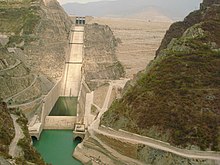Tehri Dam
| Tehri Dam | |
|---|---|

The dam in 2008
|
|
|
Location of Tehri Dam in India Uttarakhand
|
|
| Country | India |
| Location | Uttarakhand |
| Coordinates | 30°22′40″N 78°28′50″E / 30.37778°N 78.48056°ECoordinates: 30°22′40″N 78°28′50″E / 30.37778°N 78.48056°E |
| Status | Operational |
| Construction began | 1978 |
| Opening date | 2006 |
| Construction cost | US $1 billion |
| Owner(s) | THDC INDIA LIMITED |
| Dam and spillways | |
| Type of dam | Embankment, earth and rock-fill |
| Impounds | Bhagirathi River |
| Height | 260.5 m (855 ft) |
| Length | 575 m (1,886 ft) |
| Width (crest) | 20 m (66 ft) |
| Width (base) | 1,128 m (3,701 ft) |
| Spillway type | Gate controlled |
| Spillway capacity | 15,540 m3/s (549,000 cu ft/s) |
| Reservoir | |
| Total capacity | 4.0 km3 (3,200,000 acre·ft) |
| Surface area | 52 km2 (20 sq mi) |
| Power station | |
| Commission date | 2006 |
| Type | Pumped-storage |
| Turbines | Vertical Francis turbines |
| Installed capacity | 1,000 MW (1,300,000 hp) Max. planned: 2,400 MW |
The Tehri Dam is the Highest dam in India and one of the highest in the world. It is a multi-purpose rock and earth-fill embankment dam on the Bhagirathi River near Tehri in Uttarakhand, India. It is the primary dam of the THDC India Ltd. and the Tehri hydroelectric complex. Phase 1 was completed in 2006, the Tehri Dam withholds a reservoir for irrigation, municipal water supply and the generation of 1,000 megawatts (1,300,000 hp) of hydroelectricity. The dam's 1,000 MW pumped-storage scheme is currently under construction with expected commissioning in May 2018.
A preliminary investigation for the Tehri Dam Project was completed in 1961 and its design was completed in 1972 with a 600 MW capacity power plant based on the study. Construction began in 1978 after feasibility studies but was delayed due to financial, environmental and social impacts. In 1986, technical and financial assistance was provided by the USSR but this was interrupted years later with political instability. India was forced to take control of the project and at the first it was placed under the direction of the Irrigation Department of Uttar Pradesh. However, in 1988 the Tehri Hydro Development Corporation was formed to manage the dam and 75% of the funding would be provided by the federal government, 25% by the state. Uttar Pradesh would finance the entire irrigation portion of the project. In 1990, the project was reconsidered and the design changed to its current multi-purpose. Construction of the Tehri Dam was complete in 2006 while the second part of the project, the Koteshwar Dam was completed in 2012.
The dam is a 260.5 m (855 ft) high rock and earth-fill embankment dam. Its length is 575 m (1,886 ft), crest width 20 m (66 ft), and base width 1,128 m (3,701 ft). The dam creates a reservoir of 4.0 cubic kilometres (3,200,000 acre·ft) with a surface area of 52 km2 (20 sq mi). The installed hydrocapacity is 1,000 MW along with an additional 1,000 MW of pumped storage hydroelectricity. The lower reservoir for the pumped-storage plant is created by the Koteshwar Dam downstream.
...
Wikipedia

